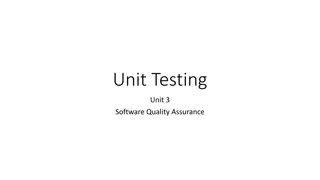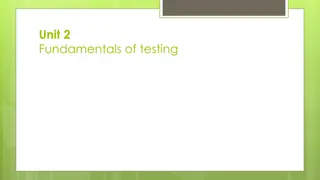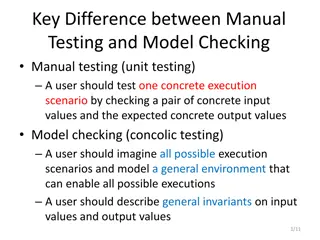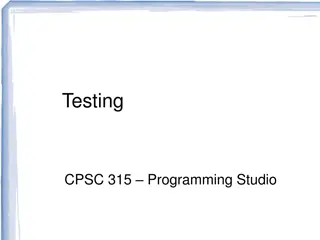The Importance of Testing Programs
Testing programs is crucial for ensuring they function correctly and efficiently before being deployed to users. It helps identify errors, enhances code safety, and facilitates code modification. Learn about different types of tests and why testing is essential in software development.
Download Presentation

Please find below an Image/Link to download the presentation.
The content on the website is provided AS IS for your information and personal use only. It may not be sold, licensed, or shared on other websites without obtaining consent from the author.If you encounter any issues during the download, it is possible that the publisher has removed the file from their server.
You are allowed to download the files provided on this website for personal or commercial use, subject to the condition that they are used lawfully. All files are the property of their respective owners.
The content on the website is provided AS IS for your information and personal use only. It may not be sold, licensed, or shared on other websites without obtaining consent from the author.
E N D
Presentation Transcript
Why do we test code? Programs need to work before we send it off to the user The user shouldn't be finding errors in our code. And they shouldn't be expected to fix the code. Testing can answer the following questions: Does it correctly do the desired task? Does it do it efficiently? Testing can also make it safer for us to modify or extend code If it works before we made changes and now it doesn't, we know where the error is.
Testing programs For simple programs, we can simply inspect the code to verify that it is correct But there is a limit to what you can do with simple programs As programs become larger inspection isn't always feasible. it becomes harder to verify how different parts of the code interact with one another there may be more than one developer working on the code
Putting the space shuttle together What would happen if you tried to assemble the space shuttle with "untested" parts (i.e., parts that were built but never verified)? It wouldn't work, and you probably would never be able to make it work Cheaper and easier to just start over
Types of tests There are different types of tests Unit tests tests for small individual parts of a program Integration tests test how different parts of the program work with one another System tests test how the entire program works as a whole Performance tests how quickly does the program perform its tasks Usability tests how easy is the program to use/understand and more We'll be focusing on Unit Tests in this class You'll see more in future classes, or you can take CS 329 Testing, Analysis & Verification
Types of test Access to data In addition to testing the various areas of responsibility as described on the previous slide, we can look at testing in relation to how much access it has to a program's internal state. White-box Testing The test has knowledge of, and access to, the internal data of classes and algorithms of methods and functions Allows for fine-grained verification of algorithm implementation Can be brittle if the algorithm changes, all the tests have to be rewritten Black-box Testing The test doesn't know anything about the program's internals Can only check that correct thing happened given specific inputs Allows for changes without rewriting test code as along as behavior is the same
Unit Tests A unit is any small part of a program here we are talking about functions and classes Unit testing, which is done by the developer, involves writing a series of tests to verify that the code does exactly what it is supposed to do Works properly with good input Properly handles bad input Properly handles failure modes Tests should be small, fast, and easy to run so you can continually test the code as you develop
What makes a good test? Features of good tests Automated and fast Only report errors Tests are independent of each other Try for 100% code coverage Tests error and border cases Tests should be maintained along with the code to allow for regression testing If running old tests that passed now fail after making a change, the code has regressed and there is a bug in the new code
Picking good tests It s not possible to test every possible input into a function to verify that it works correctly Instead, programmers need to pick a representative sample of input Input that exercises every branch in the function Boundary cases Something from each good and bad data range Each test should verify a single aspect of the code. If you want to test something else, write a separate test. With a good set of tests, there will often be more test code than code being tested, often 2-4 times as much
Test driven development Test driven development (TDD) is a programming paradigm that focus on incremental development and testing. Developed or "rediscovered" by Kent Beck in 2003, it encourages simple software design and helps inspire confidence in the code. In this programming paradigm you write the test first, and then write the code that passes the tests. And you do this for every piece of functionality in your program.
Test driven development cycle Add a test - The test should pass if the code properly performed some piece of its functionality properly computes a value, properly throws an error, etc. Run all tests The new test should fail since you haven't written the code yet. Write the simplest code that passes the test It doesn't need to be pretty, efficient, or easy to understand. It just needs to work and shouldn't do anything beyond the bare minimum. Run all tests Now they should all pass if the code is correct. Refactor as needed Go back an make the code more efficient, easier to read, easier to maintain, etc. Run the tests after each change to make sure it is still working. Repeat now move on to the next bit of functionality
Testing frameworks Tests are usually written using a testing framework that provides us with tools to create meaningful and useful tests. The testing framework provides a way to run all the tests written Makes it easier to run tests Allows for automation Typically, test run through the harness only report errors, if everything works, nothing happens "No news is good news" philosophy. Only report the things the developer needs to worry about. Also, if successes and failures are reported, it's often hard to find the failures.
doctest and pytest You've already been exposed to two different testing frameworks in this class doctests This is probably the one you thought of first. simple tests you can put in the doc strings of functions tests how the functions respond in the interpreter pytest framework This is a much more extensive framework for building tests The auto-grader tests that we give you as part of your assignments are written using the pytest framework library. We're going to talk about how to write tests using both of these frameworks
Doctests The functionality for doctests is built into the standard Python library Doctests are written in the doc string at the beginning of a function They mimic an interactive Python interpreter session They describe a series of commands to be executed each command is proceeded by ">>>", the Python interpreter prompt After each command, the expected output of that command is listed def square(x): """ returns the square of x for any value. >>> square(10) 100 >>> square(3.1415) 9.86902225 """ return x * x
Running doctests Doctests are invoked by running the script with the m doctest flag python m doctest <filename> This runs the doctest for every function in the file that has tests defined. If all goes well and all tests pass, nothing is printed. If you want to see what is being done and have output even for passed cases, you can use the "-v" flag python m doctest v <filename> The full library documentation can be found at https://docs.python.org/3/library/doctest.html
Doctest error output If the doctest fails, you'll get output like the following: ********************************************************************** File "C:\Users\dagor\PycharmProjects\demo\test.py", line 16, in test.square Failed example: square(3.1415) Expected: 9.86902224 Got: 9.86902225 ********************************************************************** 1 items had failures: 1 of 2 in test.square ***Test Failed*** 1 failures. Failed example and line number Expected and actual results Items with failures (and how many) Total failures in entire file
The pytest library To use pytest, you first need to install the pytest library as it is not part of the standard Python installation python m pip install pytest However, you've already installed it as it was installed when you installed the byu_pytest_utils library. Full documentation on the pytest library can be found at https://docs.pytest.org pytest provides a more versatile and powerful set of tools than are available from doctests
Running pytests If you've run the tests we've provided for the assignments, you've seen the basic way to invoke pytest that runs all tests in the directory: pytest or python m pytest You can additionally just have pytest run a single test file by giving the name of the file you want it to run pytest <filename> You can also have it run just a single test within the file by giving it the name of the test function after the filename separated by "::" pytest <filename>::<testname> For other ways to invoke pytest, see the documentation at https://docs.pytest.org/en/7.4.x/how-to/usage.html
What does pytest actually run? When you invoke pytest without a filename, it looks in the current directory for any files that match either of the following patterns test_<name>.py <name>_test.py If you invoke it with a filename, it just runs the file specified. Within that file, it looks for functions of the form test_<name>() and runs each of those functions in turn. These functions should take no arguments
Pytest output - success If all the tests pass, you'll see something like this ========================== test session starts ========================== platform win32 -- Python 3.9.13, pytest-7.4.0, pluggy-1.2.0 rootdir: C:\Users\dagor\PycharmProjects\demo plugins: byu-pytest-utils-0.7.2 collected 2 item green means no failures How long it took All the tests ran test_demo.py .. [100%] =========================== 2 passed in 0.25s ===========================
Pytest output - failure When test fails, there is a bit more output: ========================= test session starts ========================== platform win32 -- Python 3.9.13, pytest-7.4.0, pluggy-1.2.0 rootdir: C:\Users\dagor\PycharmProjects\demo plugins: byu-pytest-utils-0.7.2 collected 2 items One entry per test: . = succuss F = failure All the tests ran red means failures test_demo.py .F [100%] =============================== FAILURES =============================== ______________________________ test_error ______________________________ Test that failed def test_error(): > assert func(3) == 5 E assert 4 == 5 E + where 4 = func(3) Actual line that failed Values that failed test_demo.py:9: AssertionError ======================= short test summary info ======================== FAILED test_demo.py::test_error - assert 4 == 5 ===================== 1 failed, 1 passed in 0.18s ======================
Writing tests - naming Typically, our tests will go in a separate file and import the functions or classes we want to test Inside that file, we write our test functions Function names are of the form test_<name>() and take no parameters <name> should be something descriptive that makes clear what is being tested test_square_returns_valid_value() test_sqrt_throws_exception_for_negative()
Writing tests - content What goes inside our test functions? Anything we want The most common statement is an assertion assert <Boolean expression> We call the function we are testing with known input values We then assert that all we received all the expected outputs For pure functions, we just need to check the return values For non-pure functions, we also need to test the side effects def test_square_valid(): assert square(3) == 9
A more complicated example def test_grid_constructions(): grid = Grid(2,2) assert grid.height == 2 assert grid.width == 2 for x in range(grid.width): for y in range(grid.height): assert grid.get(x,y) == None With multiple asserts, all must pass for the test to pass The test will stop on the first failure.
Checking for exceptions While assertion is the most common thing we do in the tests, pytest provides a number of other checks we can make A common one is to see if an exception is raised where it is expected This uses the raises() function from pytest def square_root(x): if x < 0: raise ValueError("Negative numbers not allowed") return sqrt(x) def test_square_root_raises_exception(): with pytest.raises(ValueError): square_root(-4)
Checking floating point numbers What happens if we run the following in the Python interpreter? 0.1 + 0.2 == 0.3 Surprisingly, we get False This is due to the imprecision of floating-point number representation in computers You may have already seen this a few times this semester, noticeably on Homework 1 To make comparisons like this safely, we have to do something like this: abs(val1 val2) < tolerance where val1 (0.1+0.2 from above) and val2 (0.3 from above) are the values we ant to compare and tolerance is some small value like 1e-6
Checking floating point numbers But that's a pain to write pytest gives us an approx() method that allows us to write this more cleanly: val1 == approx(val2) i.e. 0.1 + 0.2 == approx(0.3) This would return True. If you want to change the tolerance, for example when working with large or small numbers, there are additional parameters to approx() that you can set. The full documentation is here: https://docs.pytest.org/en/7.4.x/reference/reference.html#pytest- approx























